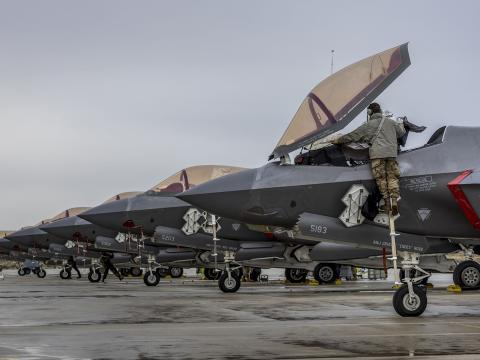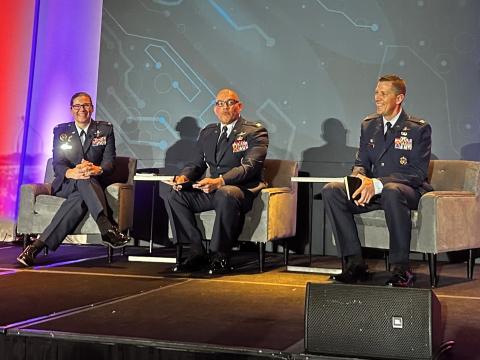Aging the Fleet Gracefully
U.S. Air Force leaders strategize to keep older aircraft viable with modest funding.
The U.S. Air Force’s toughest opponent in its mission to maintain air supremacy may be the march of time. Its aircraft are flying more hours and serving well past their original service lifetimes, and new network-centric operations are impelling technology upgrade across all wings.
During the Reagan administration, aerospace was one of the major focuses of the U.S. Defense Department. But by the end of the 1980s, information technology had taken center stage. The aerospace industry had to adjust to shrinking defense investments and to a changing, information-technology-focused economy.
This transition has led leaders to question how the U.S. Air Force can remain an effective fighting force with reduced aerospace funding and the average age of aircraft projected to double.
According to Brig. Gen. Rosanne Bailey, USAF, director of the Aeronautical Enterprise Program Office (AEPO), Aeronautical Systems Center, Air Force Materiel Command, Wright-Patterson Air Force Base, Ohio, diminished funding is not the sole issue. She notes that when decision makers reviewed proposals to procure new airplanes and looked at the average age of aircraft already in service, 15 years, it became clear that even if everything in the plan was purchased, the average craft’s age would still grow to 30 years.
Concern arose about what would happen with aircraft and their systems at this age. “Answers to these types of questions couldn’t be given,” Gen. Bailey says. “Except one. It was becoming extraordinarily expensive to keep supporting systems the way we were doing it, which was without a strategy. Whatever came along we attacked and fixed, but there wasn’t a strategy. It was clear we couldn’t buy our way out of this problem.”
The AEPO decided to change the focus of Air Force decision making from a program-centric perspective to one that is enterprisewide to leverage investment and interoperability across aerospace vessels and systems. Gen. Bailey is working on developing and maintaining a comprehensive long-range strategy to find crosscutting solutions—those that can be applied across multiple platforms—to support affordable current and future mission capabilities. Ideally, the solutions will be developed one time and applied to numerous aircraft types or, in some cases, applied to other areas such as to a maintenance process, depot process or a philosophy of how to purchase avionics replacements.
“When we restore aging aircraft, we aren’t trying to restore them back to their original condition,” Gen. Bailey explains. “We’re trying to bring them along so that they can continue not only to fly but also be relevant for the types of fights that the Air Force wants to engage in. We began trying to figure out how to keep up with the rate of change of technology, the rate of departure of manufacturing sources for avionics parts, and the desire for ever-increasing memory and processing speed.”
Wright-Patterson avionics engineering experts developed a concept known as viable combat avionics (VCA), which is the ability to efficiently support a system’s current and future affordability and capability needs. Over the life of a system, avionics viability includes production, support and operational capability requirements—from hardware and software to verification testing and support environments. The aim is to take the problem of aging aircraft and the issues surrounding aging aircraft such as avionics, wiring systems and depot upgrades and integrate them into a big picture of aeronautical product-line management, including front-end development planning. “This gives us the full spectrum from a twinkle in the eye to the point where we put the aircraft in the bone yard,” says Col. Michael Carpenter, USAF, aging aircraft planning division chief at the AEPO.
Some of the VCA performance goals include making a system design and its implementation “producible” so that additional development is not needed at the end of the cycle. Additionally, system design, its implementation and documentation will be able to efficiently support future capability expansions, allow software updates and enable newer components to be swapped with old ones to improve reliability, reduce support costs and make a system relevant.
Contractors will be evaluated and chosen based on their ability to fulfill the VCA tenets. “The methodology has been incorporated into what you can do legally in a contract and tells us how to go about rewarding that behavior in an award program,” Gen. Bailey shares. “The value of this is that you can apply it to any avionics upgrade and the next upgrade should be easier because you’ve already established requirements such as software portability or ease of verification. We’re assuming we’ll have to do tech refresh, so we’ve asked how to design the program’s contracting strategy, not the system itself, in such a way that we can reward the contractors for thinking past the initial contract into the future about how to keep avionics viable over time.”
Col. Carpenter adds that the principles behind VCA are something equally applicable to any electronics system. “The way we buy avionics, the processes we use and our culture need to change,” he attests. “This is because the avionics industry and electronics industry turn over everything so quickly and everything goes obsolete quickly. We have to think differently in the way we buy. It’s becoming a joint issue.”
Gen. Bailey also is thinking in joint terms as another way to manage aging aircraft issues. She says that a knowledge management system has been widely requested by Air Force decision makers. The system would enable users to locate others who have been confronted with related problems and have found solutions.
“This is not only for Air Force aging aircraft but for all of the services and the airlines,” she explains. “Let’s say you are the owner of an old bicycle that’s single speed and your requirement has gone from riding two miles to 10 miles. If you only think in terms of bicycles, you may think that you will have to get in better shape to go faster, buy a rain suit, set up a wind screen and wire a heating system to the frame. Or, you could have looked around and found out that there are these other vehicles called cars. You could have stepped back and taken a system-of-systems approach and found a solution that already exists. It may be that you were proposing a multibillion dollar solution to a few-million-dollar problem.”
A key feature of knowledge management is the ability to tie together different systems from multiple organizations created at different times, including legacy systems. “We can mine data and improve it,” Gen. Bailey says. “We can link people in a workflow environment that allows them to bring with them the tools they know best. Then you can archive your work and look at the analysis and results. It’s the next generation of problem solving by linking brains and tools in a collaborative environment online to accelerate a task with more fidelity and richness.”
Emphasizing that aging issues are not limited to aircraft, Col. Carpenter notes that aging also affects ships, tanks, ground equipment and space equipment. “There is a lot each of us is learning about that [aging] phenomenon that we can add to the body of knowledge,” he says. “The U.S. Department of Energy is dealing with nuclear weapons storage devices. They have information on corrosion that we can use. There are going to be unusual locations of information that we’ll find that is valuable to all of us.”
But the colonel points out that crosscutting solutions are still not widely recognized and accepted. “We’re working on getting that visibility in the Air Force and trying to fund and foster the policies for that kind of approach and assist the SPO [system program office] directors with common solutions. We’re also doing this across services, across agencies and even industry. We need to cooperate and graduate to where we get more out of what meager dollars we have.”
The command’s Applied Technology Council is such a means of cooperation. The council brings together co-chairmen Air Force Research Laboratory Commander Maj. Gen. Paul D. Nielsen, USAF; Aeronautical Systems Center Commander Lt. Gen. Richard V. Reynolds, USAF; and Air Force Materiel Command Vice Commander Lt. Gen. Charles H. Coolidge Jr., USAF. The group reviews potential applied technology demonstrations (ATDs) for implementation into a system. Currently, ongoing ATDs include advanced aircraft erosion protection, advanced nondestructive evaluation for aging structures, bonded repair capability enhancement, corrosion effects on structural integrity, engine rotor life-extension program, noncritical add manufacturing—a means of adding material back in titanium parts—and aging wiring system diagnostics, which help determine where a break or short is occurring within a big wiring harness.
“We look at how we integrate with the armament, C2ISR [command, control, intelligence, surveillance and reconnaissance] and space enterprises at every level, not just the enterprise commander level,” Gen. Bailey says. “We look across the enterprises to ensure that what comes up from the bottom is integrated from the very first thought. The opportunity for industry to participate in that is key. As we think this way, we’re going to be asking industry questions the same way. What is an integrated approach to dealing with problem Y? How can we solve a corrosion issue with a process that can be used across aircraft types, services and agencies well beyond the Defense Department? How can we draw from what already has been learned from the work industry has been doing for the airlines or for other users unrelated to us?” she offers. “Think those thoughts, because we’re going to be asking.”



